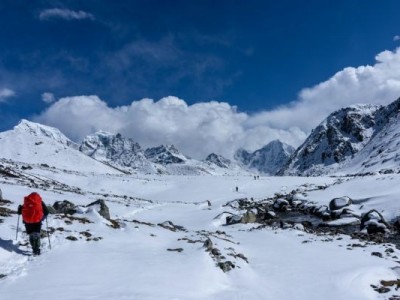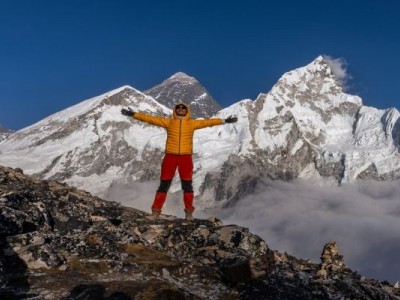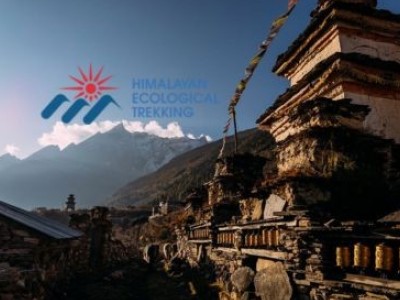The autumn season is arguably one of the most thrilling and attainable Himalayan adventures in Nepal on the Langtang Valley trek. This trek awaits people wanting bold mountain vistas, incredible cultural heritage, and rugged beauty. The trekking distance takes you through Langtang Valley, frequently called the "Valley of Glaciers," situated inside Langtang National Park immediately north of Kathmandu. September and October are wonderful months for trekking because the clear skies and comfortable temperatures make it a terrific time to explore the valley. The landscapes shine during autumn, with golden foliage, crisp mountain air, and an unobstructed view of the snow-capped peaks that stimulate the wanderlust of every trekker.
Table of Contents
Why is Autumn the Best Time to Trek Langtang Valley?
The best time to trek in Langtang Valley is in autumn (September to November). The weather is stable, the visibility is clear, and the mountain views are exceptional. Autumn weather in the Langtang Valley means warm days, cool nights, and safe trails with minimal rainfall.
In the autumn, as the monsoon winds down, Langtang Valley features the colourful autumn foliage and rejuvenated nature. The green forests of rhododendron, oak, and bamboo boast beautiful autumn colours as the terracing fields shine golden for the harvest. Autumn also brings about the opportunity for travelers to participate in Nepal's major festivals - Dashain and Tihar, celebrated with great fanfare by the local villages. Langtang Valley is less busy than the popular Everest and Annapurna regions, so trekkers are able to experience more solitude in the mountains and interact with free and genuine villagers.
The trek in Autumn to Langtang Valley is particularly favorable due to the great weather. During the daytime in Langtang Valley, temperatures range between 10°C to 20°C (50°F to 68°F) at lower elevations, where skies are sunny and rainfall is usually scarce, allowing dry and safe hiking. At higher elevations such as Kyanjin Gompa (3,870m), you can expect temperatures between 5°C to 15°C during the daytime as well. Because of the temperature variations between day and night, you should be ready for cool (not cold) nights ranging from -5°C (23°F) to 5°C (41°F) at higher elevations. Not only does the season offer good weather, but it also offers better mountain views of Langtang Lirung (7,227m), Ganesh Himal, and Dorje Lakpa, resulting in favorable conditions for trekkers. In addition to good weather, Autumn is the best season for trekking in Langtang Valley, as every month of this season is an experience like no other that can offer the Tamang ethnic culture, Buddhist customs, stunning natural beauty, and friendly hospitality from the mountain people.
Langtang Valley Trek in September - Transitioning Weather
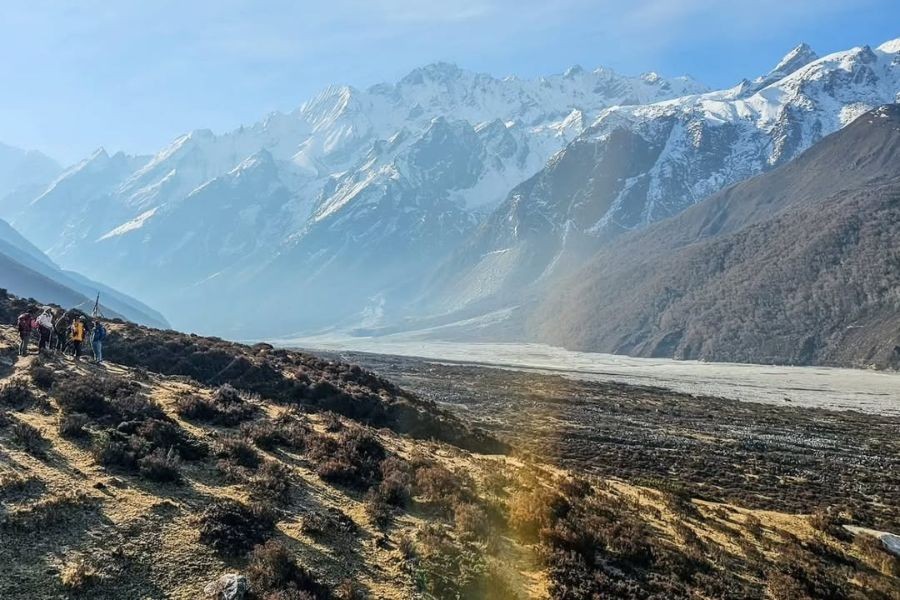
September signifies a glorious shift from the days of monsoon to those of autumn in the Langtang Valley. After months of rain, the valleys are lush and green, and wildflowers are in full bloom, splashing color across the hillsides. The green hills and forests exist in stark contrast to the rapidly clearing air, welcoming trekkers into the arms of nature. The Langtang Valley trek in autumn is a wild fling through the colorful perfumes of wildflowers, exuding glimpses of glory and rejuvenating doses of the land.
- Related article: Best Time to Trek Langtang Valley: A Complete Seasonal Guide
Weather and Temperatures in September
The aftermath of the monsoon brings new colors to Langtang Valley in September. Above 3,500 meters, such as Kyanjin Gompa, temperatures drop to between 5°C and 15°C. Below 3,500 meters, such as Lama Hotel and in the Langtang village, temperatures elevate to between 10°C and 20°C. It is still mildly raining as it is at the tail end of the monsoon. However, it does make the beauty all the more dramatic while you are trekking the days away. Naturally, with all the sunshine air becomes much clearer, which does provide additional benefits while trekking to view panoramic mountain views.
The Beauty of Nature and Cultural Experience in September
September showcases Langtang Valley's extraordinary contrasts of color and texture not seen at other times of the year. Terraced rice fields, dense forests of rhododendron and bamboo, and waterfalls cascading down rocky cliffs provide a breathtaking experience for outdoor enthusiasts. Rivers swollen by the monsoon rains flow in abundance, creating a symphony of sounds, spilling over the banks while trekkers become entranced and immersed within the beauty around them. The trek itself becomes more preferable by the greenery of the land, combined with interactions with the local Tamang and Tibetan Buddhist culture. These encounters take place within the villages like Langtang and Kyanjin Gompa, where visitors can witness yak cheese herding animals and cheese factory visits.
Trekking Experience in September
Trekking in September will satisfy your sense of adventure and sense of wonder about the great outdoors. The trails have been reclaimed by the monsoon showers and are delightful to trek, as most of the dirt has settled out of the air, providing a cleaner atmosphere. The amazing scenery and lively trails allow for rest and comfort in the beautiful post-monsoon properties to provide a rewarding trekking experience. Additionally, there are fewer people than in other trekking months, allowing greater opportunities for serenity in the peacefulness of Langtang Valley. Views of roaring waterfalls, crisp mountain air, and views of the ever-changing beauty of the valley will forever capture brilliant memories for every trekker in September.
Dashain Festival in September – A Cultural Delight for Trekkers
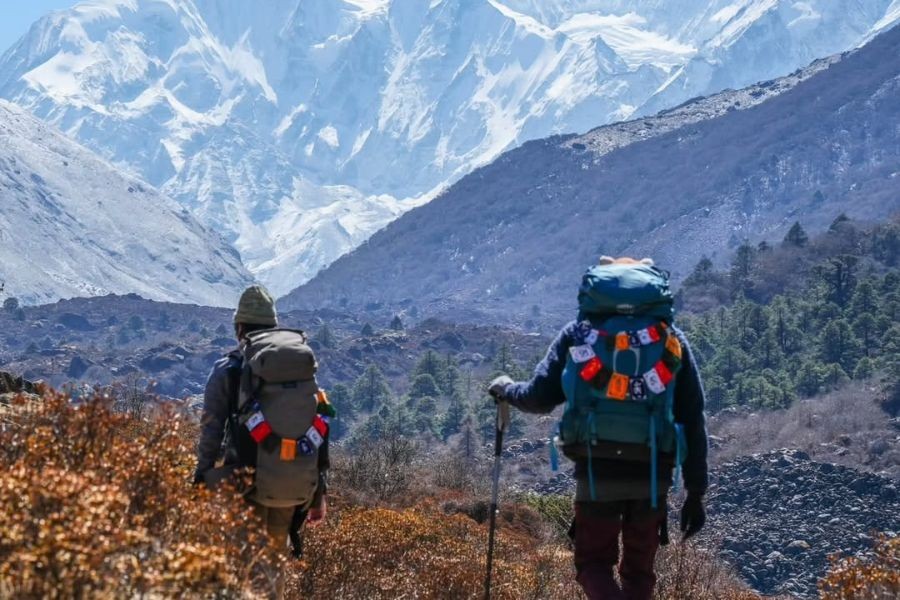
Dashain, Nepal's main Hindu festival, is usually held in September or October. Dashain signifies the victory of good over evil, and it is a time when Nepalese families engage in religious celebrations, big feasts, and visit family members to receive blessings. The festival takes place in the autumn, right after the monsoon, when the weather is pleasant, and the scenery is spectacular with greenery everywhere.
The villages within Langtang Valley come alive during Dashain celebrations with religious occasions, traditional music, and prayer at Buddhist monasteries and Hindu temples. The land of temples is given a festive ambiance with elaborate Hindu and Buddhist decorations. The Langtang Valley has the Buddhist Tamang population, yet because the valley is so close to Kathmandu, Hindu practices are present, and most visitors will have chances to watch or participate in events from the two traditions. Village people are generous in inviting visitors into their homes to share meals, partake in family activities, and receive blessings from celebratory practices. Kite flying, bamboo swings, and wearing new clothes all contribute to the festive atmosphere.
The spiritual significance of Dashain adds to the adventure, as monks lead special ceremonies in monasteries such as Kyanjin Gompa, creating an atmosphere of profound spiritual connection. During September, trekking in Nepal becomes particularly special, with golden terraced fields, fluttering prayer flags, and vibrant community celebrations among the Tamang people.
Langtang Valley Trek in October (Peak Trekking Season, Favorable Weather)
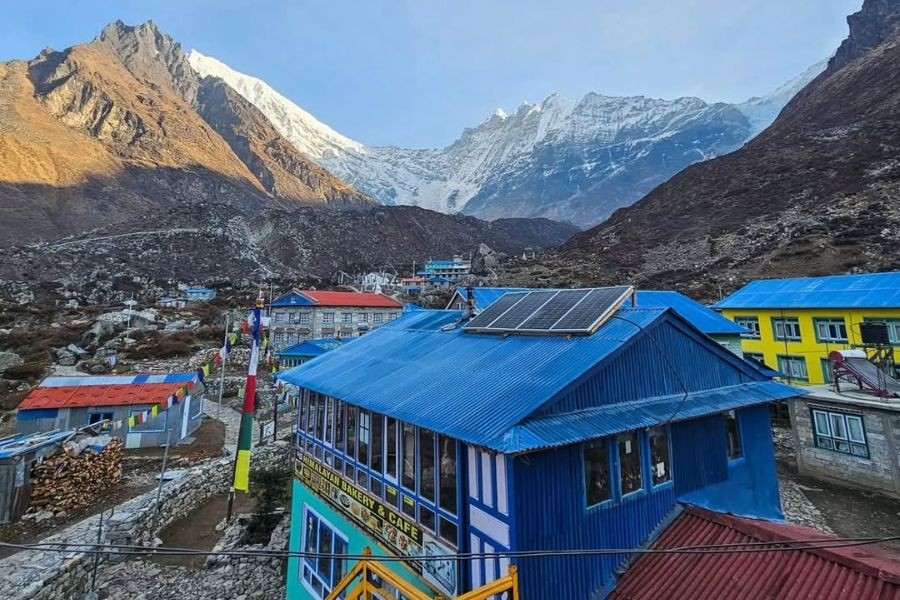
October is the best month for trekking activities to explore the grand gem of the Himalayas - the Langtang Valley Trek. Langtang Valley is situated in the Rasuwa district, north of Kathmandu. The area is captivating and is famous for amazing mountain views, Tamang and Tibetan cultural aspects, and amazing natural beauty. The autumn months in Langtang Valley present an unbeatable trekking experience for those who wish to hike in one of the best trekking areas in Nepal.
October is a great month for trekking because October is deep in the fall trekking season. After the monsoon season, fall brings crisp blue skies, creating the best weather for viewing the Himalayas. With the comfortable and stable weather, October is the best month to be there, while winter brings fluctuating, intense cold, heavy snow accumulation, and limiting factors at the higher elevations.
Weather and Temperature in October
It is quite spectacular to take in clear blue skies and sweeping mountain views of the Langtang Lirung (7,227m), Ganesh Himal, Dorje Lakpa, and Langshisa Ri due to refreshing weather patterns that come after the monsoon season. Temperatures above 3,500 meters, like Kyanjin Gompa and Tserko Ri viewpoint (4,984m), range from 5°C to 15°C during peak days - meaning these temperatures are comfortably manageable for trekkers. The lower elevation areas below 3,500 meters, like Syabrubesi, Lama Hotel, and Langtang village, report daily temperatures between 10°C to 20°C, allowing for the most comfortable trekking conditions. Typically, October features little rain, keeping trails dry and safe throughout your journey.
Scenic Beauty and Cultural Immersion in October
The Langtang Valley is at its most colorful in October when beautiful natural footage meets the cultural experience of festivals held annually in this valley on the border of Tibet. The autumn colors cover the valley in bright gold, amber, and red hues, making the trek even more spectacular. In autumn, the sun provides the brightness after the monsoon, and the valley attains its highest fertility, revealing lush forests, vivid meadows, and ripe golden patches of crops. Trekkers can experience Tibetan Buddhist festivals in October and witness the rituals and festivities at significant locations, such as Kyanjin Gompa and the old monastery located in the Langtang village. Visitors to the local cheese factory located at Kyanjin Gompa can utilize it as a cultural experience to taste yak cheese and watch the traditional science of cheese making.
Trekking Experience in October
Trekking in Langtang Valley in October is an ideal trek that combines unique adventure, beautiful nature, and spiritual discovery. Trekking in October is easy due to the moderate temperatures, creating warm conditions throughout the dry trails. The trek becomes even easier as the weather becomes stable with clear routes, which allows trekkers to spend less time battling the elements and more time on views and cultural experiences.
The Himalayas also provide the most phenomenal photography opportunities in October, when photographers can get breathtaking shots of the snow-covered range, ancient monasteries, Tamang villages, grazing yaks, and vibrant fall colors. The optional side hikes, Tserko Ri (4,984m) or Kyanjin Ri (4,773m), come with spectacular sunrises over Langtang Lirung and surrounding peaks.
If you are a trekker seeking a true Himalayan experience close to Kathmandu, October is undoubtedly the best time to trek to the Langtang Valley in Autumn. The combination of great weather, stunning views, and a cultural experience is sure to be unforgettable! Whether you are an experienced trekker or new to trekking, Langtang Valley in autumn guarantees a peaceful experience, an opportunity for inspiration, and the unique experience of all things Himalayan in ways that no other season can. So grab your bags, lace your boots, and take the opportunity to trek of a lifetime this October.
Festivals in October During the Langtang Valley Trek
When trekkers make their way to Langtang Valley in autumn, there is a special cultural landscape that embodies various celebrations and festivals, such as Tihar and different Buddhist ceremonies, that represent the fusion of Hinduism and Buddhism within the striking backdrop of the Himalayas.
Tihar Festival
Tihar, or the festival of lights, is celebrated during late October and early November in Nepal. Trekkers walking through villages will witness the valley lit up from butter lamps placed in windows and the facades of houses, and enjoy rangoli, or traditional decorations, greeted with colors. Even if Langtang Valley is a predominantly Tamang Buddhist area, penetrating influences from surrounding lowland Hindu cultures allow trekkers to witness the celebration of Tihar.
For example, various songs (s) called Deusi-Bhailo are sung by children and adults, who go and visit houses in the evenings singing songs as a way to receive gifts and sweets that might come into their homes.
Trekkers might get invited into the house of a local family or into a community gathering in order to participate in Laxmi Puja, where villagers worship wealth and prosperity by lighting lanterns of oil to welcome blessings. The celebration of Bhai Tika honors the relationship of siblings, and if trekkers (or displaced Tibetans and Nepalis) are in a family, they will be welcomed to take part in a lively atmosphere as the family dresses in their best attire to exchange tika and offerings within the family.
One unique feature of Tihar is the festival for crows and dogs (and cows), which brings a unique essence to the holiday celebrations.
Buddhist Ceremonies in October
October also has different Buddhist ceremonies conducted by monasteries in Langtang Valley. In Kyanjin Gompa, the main monastery in this region, there are prayer ceremonies where monks pray and fulfil rituals using traditional instruments, in particular horns, drums, and cymbals. The prayers echo generated spiritual energy as monks pray for peace, prosperity, and the welfare of all life.
Trekkers will notice the monks, who are dressed in maroon robes, quietly spinning prayer wheels and creating fascinating designs out of sand with the intent of creating mandalas, during their time in these ceremonies. The vibe of the Langtang Valley, along with the ceremonial and spiritual rites, is special. To the trekkers, at the end, it should be understood that attending the Hindu or Buddhist ceremonies isn't just about the experience of being a ‘festival’— it is a journey into the sacred exploration of ancient, ceremonial traditions, spirituality, and nature inside this beautiful Himalayan setting.
Langtang Valley Trek in November: Harvest Season and Crisp, Clear Weather
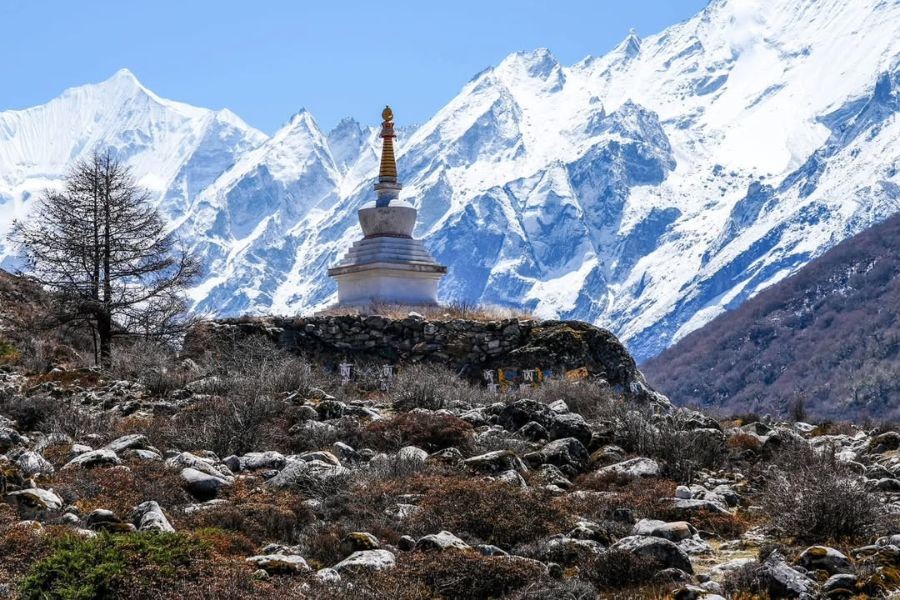
In November, the Langtang Valley Trek takes on a different atmosphere during Autumn, perfect for trekkers who prefer to trek in peaceful solitude and enjoy stunning views. As the trekking season winds down, it is cool as winter approaches. The trails are less crowded, meaning that the atmosphere could be described as tranquil, for a trekker who wants to enjoy the valley in solitude. Millennial cooling breezes and clear skies lead to stunning views of the peaks surrounding the valley, and the season of harvest lends an additional layer of beauty to this area of spectacular natural surroundings.
Weather and Temperature in November
Temperatures are dropping in November as we head toward winter, which gives trekkers a colder but great experience, while trekking. At an altitude of more than 3,500 meters, such as Kyanjin Gompa during the day, it can be between -2°C to 10°C, and under that altitude it can be between 5°C and 15 15°C. In the evenings, nighttime temperatures might drop into the freezing range at a higher elevation. There can also be an early snow, particularly late in the month, which adds to the amazing beauty and experience of your trekking journey.
Natural Beauty and Cultural Engagement
November is the time of year to observe the harvest when the golden fields of barley, wheat, and buckwheat in the valley stand out beautifully against the snow-covered peaks. The visibility is stunning after the monsoon, making for great photographs; the mountains are unbelievably close and clear, with Langtang Lirung clearly visible on the skyline in its full splendor.
On the trails, trekkers can observe local people involved in their traditional activities to prepare for the cold: drying vegetables, storing grain, and driving yaks to lower pastures. The Tamang people practice traditional Tibetan Buddhist beliefs, and visitors can watch local life in this remote valley in the Himalayas. The peacefulness of the trails creates the best opportunity for deeper engagement with the kindhearted cultures that uphold traditions from centuries ago.
Trekking Experience in November
Trekking in November is tranquil and gratifying, with far fewer people on the trails than during the busy autumn months of September and October. The fresh, crisp air is energizing, and there is always a bit of magic in witnessing snowfall while on your journey. Days are pleasant and warm for trekking, while nights will require several warm layers and good sleeping bags to keep you cozy. November is a glorious and peaceful time to enjoy the scenery, clean mountain peaks, and early winter experiences for those who can handle the cold temperatures while exploring the hidden beauty of Langtang Valley.
Having the chance to witness the snow-dusted landscape builds the winter wonderland feel, especially up higher. Watching the sunrise from Kyanjin Gompa or Tserko Ri is especially impressive with frost-covered peaks gleaming in a golden sun.
Festivals in November
Mani Rimdu Influence
Though Mani Rimdu is mainly held in the Everest region, its influence of Buddhism can be seen in monasteries in Langtang valley in November. In Kyanjin Gompa and smaller monasteries, prayers and monks may engage in rituals, prayers, and dances in ceremonial masks for auspiciousness and purification from negativity to bring peace. And with the teaching of Buddhism being honored, the sounds of traditional instruments resonate in the adjacent space.
Local Harvest Celebrations
In November, it's also the timing of the local harvest festivals when Tamang communities give thanks for their successful crops. These festivals can often entail community meals, traditional dances, and public offerings at a local monastery. Trekkers fortunate to visit these areas at the same time will experience genuine gastronomical and cultural experiences, sharing meals with locals, consuming local foods, and learning about Tamang and Tibetan customs.
Because the dates of local festivals can vary from year to year based on the lunar cycle and local tradition, it is best to verify with local guides and tour operators for more accurate information during your trek.
Practical Information for Langtang Valley Trek in Autumn
Permits Required
Before coming to the Langtang Valley trek, trekkers must obtain a Langtang National Park entry permit and a TIMS (Trekkers' Information Management System) card. These permits aid in preserving and protecting the area as well as the safety of trekkers. Langtang National Park is home to a rich diversity of fauna, including red pandas, Himalayan black bears, and numerous bird species; thus, conservation is vital.
Trek Distance & Duration
The Langtang Valley trek starts in Kathmandu with a beautiful drive to Syabrubesi, approximately 145 kilometers (6-8 hours by road) away. The actual trek normally lasts between 7 to 10 days, depending on your trek speed and trek itinerary. The conventional itinerary would be Syabrubesi → Lama Hotel → Langtang Village → Kyanjin Gompa, with the possibility of acclimatization days with some side trip to either Tserko Ri or Kyanjin Ri, then returning the same track.
Trek Difficulty
The Langtang Valley trek is a moderate-level trek that requires good fitness. Each day, trekkers will walk between 5 and 7 hours, with a steady gain in altitude that requires good acclimatization while at Kyanjin Gompa (3870m), before heading out to the higher views. The trails are well-maintained, and a teahouse is available throughout, making accessibility friendly for new trekkers to the Himalayas.
Cost Considerations
The Langtang Valley trek cost during the autumn season varies depending on factors like hiring a guide/porter, accommodation, and personal expenses. Teahouse accommodations are of a marginally higher price during the spring compared to autumn, but remain moderately priced during the spring, and are higher basic accommodations that can raise the cost marginally, during the higher elevation. The trek offers good value compared to other treks in the Himalaya for being shorter and closer to Kathmandu.
Accommodation
Comfortable teahouse accommodation is available along the trek at every major stop. The family-run lodges have basic but clean rooms with shared facilities, dining halls with heaters (available at an extra cost), and a selection of traditional Nepali and Tibetan foods. The hospitality of the local Tamang families makes the accommodation experience a cultural treat.
Frequently Asked Questions
What makes autumn the ideal season for trekking in Langtang Valley?
Autumn (September-November) has pleasant temperatures, little rain, and superb views under bright blue skies, allowing for a fantastic trekking adventure. You’ll see incredible autumn colors, fresh mountain air, and wonderful views of Himalayan peaks like Langtang Lirung (7,227m).
What is the level of difficulty for this trek in Langtang Valley in autumn?
The difficulty is considered moderate, where you can hike and trek for 5-7 hours every day with manageable ascents. Autumn is a good season for trekking because of the nice weather, drier trails, and stable temperatures, which allow the trek to be comfortable and enjoyable. The trek requires some knowledge of trekking, taking a good number of precautions, and carefully acclimatizing yourself at Kyanjin Gompa.
What permits do I need to trek to Langtang Valley in autumn?
Yes, trekkers should get a Langtang National Park entry permit and a TIMS (Trekkers' Information Management System) card. Before trekking, you must complete all of the documentation prior to beginning the trek — typically arranged by your trekking agency.
Which festivals can I experience on the Langtang Valley trek in the autumn?
Autumn is a time of major festivals, including the Dashain festival (September/October) and the Tihar festival (October/November), along with Buddhist festivals at monasteries. These provide chances to experience local culture, observe rituals, and enjoy celebrations with friendly locals.
Is the Langtang Valley safe for trekking after the 2015 earthquake?
Yes, the Langtang Valley is now open and safe for trekking. The trails have been rebuilt, communities have rebuilt their villages, and even new lodges have been built. The resilient local communities are happy to have trekkers back, and the valley is recovering beautifully. Visiting helps support rebuilding that is still in progress.
How fit do I need to be for the Langtang Valley trek?
A moderate level of fitness is required. If you can comfortably walk and hike 5 to 7 hours each day with a daypack, you will be able to trek in the Langtang Valley. We recommend committing to cardiovascular exercise leading up to your trip, some hiking practice, and generalized fitness. The trek gains elevation gradually, which helps you acclimatize.
Conclusion
The Langtang Valley Trek is among the top treks to enjoy in Autumn, as it brings together nature, culture, and spirituality into one incredible journey. September offers colorful terraced landscapes and blooming flowers, October features crystal clear skies and many festivals, and November is a mild blend of harvest beauty and quiet solitude. Whatever you are searching for, it is bound to be a special experience for any adventurous spirit.
Hiking in the faraway and remote Langtang Valley in Autumn will be a lifetime experience for that perfect weather, incredible views of the mountains, and Tamang hospitality. The mountains and local communities have recovered from the devastating earthquake in 2015; therefore, your trek adds not merely to your journey but to the rebuilding of this beautiful area.
The Langtang Valley is an easy one to reach from Kathmandu, especially if time is limited. But in the footprint of one trek, this valley promises you experiences of those treks that take double the time and are far more remote. Adventure awaits on this journey from the biodiversity contained in the forests of Langtang National Park, to the high-altitude glacial landscapes around Kyanjin Gompa, to the simplicity of wandering through the Tamang villages, and beyond the ancient Buddhist monasteries and stupas. The variety that is contained in a trek of this distance is simply impressive.
If you would like a true Himalayan adventure interspersed with tranquility and cultural diversity in the fall, the Langtang Valley is all you need. The memories formed from the impressive mountains, trails lined with prayer flags, and the friendly people of the mountains will last for a long time after you return from your trek. Come see for yourself why the Langtang Valley is known as the "Valley of Glaciers”, and feel the charm unfold that makes autumn a wonderful time to explore this Himalayan treasure.
Join a once-in-a-lifetime adventure in autumn, trekking in Langtang Valley with Himalayan Ecological Trekking, where the beauty of the Himalayas meets warm mountain hospitality. This trek is not just a trek; it will take you to the heart of Nepal's outstanding natural and cultural riches.
Inquire Now: [email protected]
Expert Consultation: WhatsApp: +977 9851006023 (Bikesh)
.jpg)
